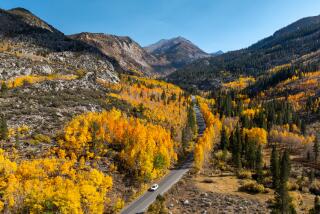Fragile beauties bloom in the harsh high desert
Some friends think I’m nuts for living in the high desert. Why, they wonder, do I put up with the howling wind, devilish heat and beige landscape?
Because once in a while the hills west of Lancaster flame into mile after mile of gloriously brilliant orange poppies. The recent winter rains suggest an epic display this year at the Antelope Valley California Poppy Reserve in Lancaster.
“In a good wildflower year, the color in the fields of poppies is unbelievable,” said Jean Rhyne, interpretive specialist with the California parks system. “I’d thought that pictures I’d seen at the state’s only poppy reserve were overcorrected to have color that bright, but last year I discovered it really happens.”
At the top of a ridge, I sit bundled against the cold wind. I love the fact that this area is rich in history. Army engineer John C. Fremont crested the hills of Tehachapi on April 15, 1844, and rode his horse down toward the Antelope Valley floor, where he became the first Anglo to write about the explosion of flowers. After a day’s ride, he noted that he “came among the fields of flowers . . . which consisted principally of the rich orange-colored poppy, mingled with other flowers of brighter tints . . . Several antelopes were seen among the hills and some large hares.”
Today you may not spot antelopes, but rabbits are a possibility, along with owl’s clover, lupine, goldfield, cream cups and coreopsis.
On March 14, the 2,000-square-foot Jane S. Pinheiro Interpretive Center at the reserve will reopen, from 9 a.m. to 4 p.m. Mondays through Fridays and 9 a.m. to 5 p.m. on weekends. The center, which made its debut in 1982, uses passive solar heating and is designed to reduce the heat from the sun.
Inside the visitor center, you’ll find a short orientation video, wildlife and wildflower displays and a gallery of Pinheiro’s detailed watercolor paintings, framed and donated by the Lancaster Women’s Club. Her paintings helped draw attention to the wildflowers, and she spearheaded the drive to set aside this land. A gift shop features wildflower-oriented items, books, jewelry and children’s articles. The reserve is open year round from sunrise to sunset, but the visitor center and activities are available only in spring.
Guided tours are offered during wildflower season. When giving tours, Rhyne shares her love of the desert.
“Most visitors drive through the desert only thinking of it as dry sand and weeds, but it’s so much more,” Rhyne said.
Unlike a botanical garden, the poppy reserve is neither tame nor well-ordered. A short section of the path into the field of flowers is paved for wheelchair use. The more able-bodied can trek on 8 miles of trails carved through fields of wildflowers that support snakes and small animals.
Other suggestions include:
* Visit during the week, when it’s less crowded.
* Go in the early morning. The wind comes up in the afternoon and poppies close.
* Leave your dogs at home. Dogs are not allowed on the trails. There are no shaded areas in the parking lot, so don’t plan on leaving your animals in the car.
From Interstate 5, take California Highway 138 east, then south (right) on 170th Street West. Turn left onto Lancaster Road. The reserve is on the left. The flower hotline is (661) 724-1180, or call to speak to a staffer (661) 942-0662. For hours and prices, see www.parks.ca.gov.
Stone is the author of “San Andreas Ain’t No Fault of Mine,” a guidebook to the Antelope Valley.
--
More to Read
Sign up for The Wild
We’ll help you find the best places to hike, bike and run, as well as the perfect silent spots for meditation and yoga.
You may occasionally receive promotional content from the Los Angeles Times.






